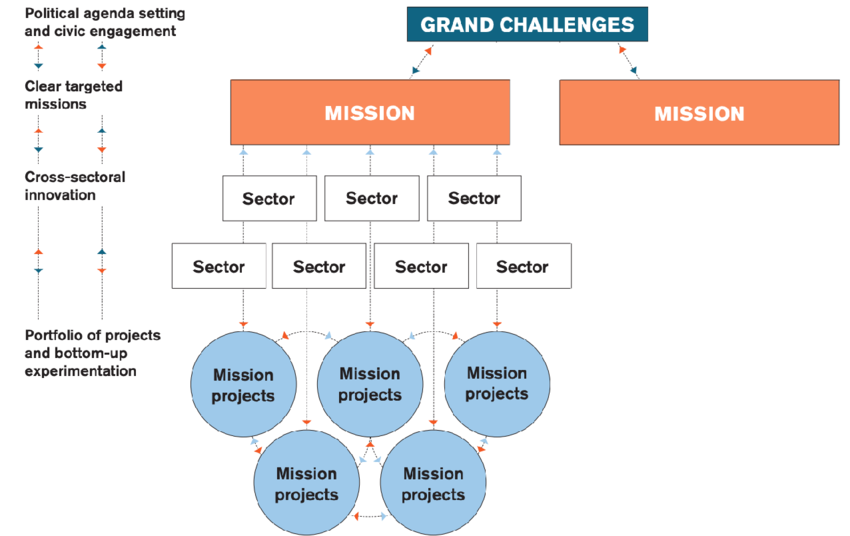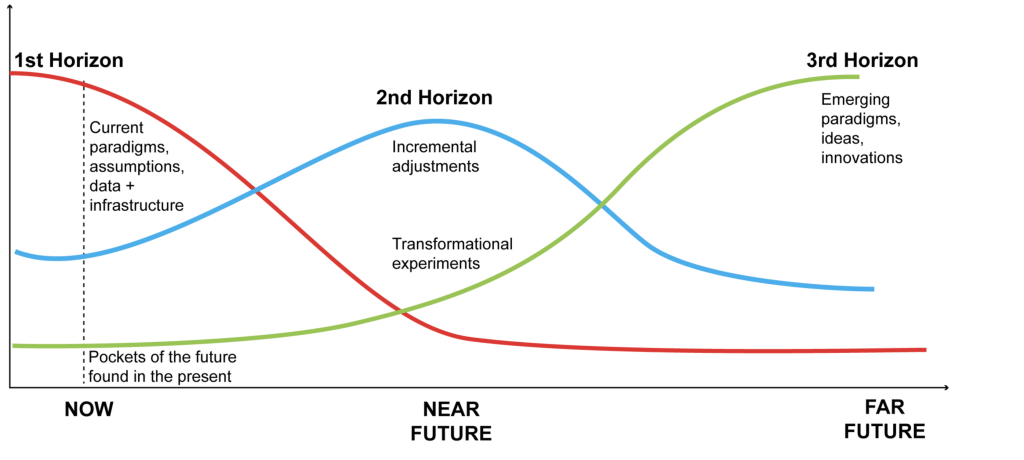· 8 min read
Seeing the forest through the trees: cohering disparate signals into tangible climate action
“It ain’t what you don’t know that gets you into trouble. It’s what you know for sure that just ain’t so.” - Mark Twain
This quote, deceptively simple, encapsulates the danger of clinging to outdated assumptions in an era of compounding climate, economic, and institutional crises. Importantly, this adage captures a fundamental flaw in much of today’s climate policy: a belief that incremental, siloed interventions are sufficient to navigate the escalating turbulence of climate change.
Sticking to established assumptions and acting in siloes subjects us to the ‘used future’, or the ‘disowned future’ - where we resign ourselves to implicit and explicit biases that skew our expectations of the future, often to our own detriment. In the context of climate adaptation, this is particularly consequential.
Despite widespread recognition of the need for integrated, cross-sectoral responses to climate change, progress has remained slow and fragmented. As a policy domain, climate change policy often lacks the operational coherence and political momentum to translate insight into action.
What is missing is not knowledge or technology, but an institutional mechanism to mobilise collective ambition, align innovation, and integrate public and private efforts toward shared goals.
Mariana Mazzucato’s concept of mission-oriented policymaking offers precisely such a mechanism (see Figure 1). More than a theoretical framework, it is a call to structure public policy around ‘mission projects’—strategic, time-bound initiatives designed to solve grand challenges through coordinated investments, regulatory tools, and institutional reform. For One Health, mission projects can serve as vehicles to overcome sectoral silos and foster innovation at the intersection of health, agriculture, ecology, and infrastructure.

Figure 1 - Mariana Mazzucato’s Mission-oriented Policymaking Framework
Resilience with Purpose: Why Missions Matter
Climate change adaptation is not just a technical issue; it is a grand challenge—a cross-cutting problem that touches every aspect of our economies, infrastructures, ecosystems, and societies. Such challenges are marked by high uncertainty, long timeframes, and deep interdependencies. Traditional policy tools, narrowly scoped and sector-bound, are ill-equipped to deal with them - often succumbing to the ills of ‘bounded rationality.’
Rather than diffuse strategies or siloed investments, the missions that underpin the grand challenge provide a visible, actionable centre of gravity around which diverse actors can coordinate. In Mazzucato’s formulation, a good mission:
• Is bold and inspirational.
• Has clear direction and targets.
• Cuts across multiple sectors and disciplines.
For example, in response to the grand challenge of climate adaptation, a mission to “ensure food sovereignty under extreme climate futures” might integrate:
• Agriculture policy (to support permaculture and climate-resilient crops),
• Energy policy (to power cold-climate greenhouses and vertical farms),
• Trade policy (to secure essential inputs and maintain seed diversity),
Mission projects could then include seaweed aquaculture trials in coastal nations, urban hydroponic hubs, single-cell protein production using captured methane, or public procurement of low-carbon foodstuffs for emergency reserves. These projects feed into each other, build capacity, and enable feedback loops that reinforce learning and adaptation over time.
Importantly, mission projects can then be co-developed with these localities, ensuring that global missions are responsive to regional dynamics. A polycentric, cooperative approach is essential in a world where supply chains are intertwined and crises cascade across borders.
This contrasts with traditional approaches to climate change adaptation, which have largely been fragmented, reactive, and technocratic - characterised by narrowly defined projects confined to specific sectors like infrastructure, agriculture, or emergency response. These efforts often lack a unifying purpose, resulting in disjointed investments, poor cross-sector coordination, and limited engagement with the broader social and economic systems that shape vulnerability and resilience. Adaptation has too often been treated as a checklist of technical fixes rather than a long-term societal transformation, constrained by short-term funding cycles and jurisdictional silos.
Room for the River - a case study of mission-oriented climate adaptation
One of the most successful examples of mission-oriented policymaking for climate adaptation is the Netherlands’ Room for the River program. Faced with rising climate risks—particularly increased river flooding due to heavier rainfall and sea level rise—the Dutch government shifted from traditional flood defence strategies (such as endlessly raising dikes) toward a transformative mission: to restore the natural flow capacity of rivers while enhancing spatial quality, ecology, and liveability.
Launched in the early 2000s, the program defined a clear public-purpose goal: to make the Netherlands climate-resilient by redesigning its river systems to “live with water” rather than fight it. This mission brought together multiple sectors, including water management, urban planning, agriculture, architecture, and community organisations. Over 30 projects were implemented across major river basins, such as the Rhine, Waal, and IJssel, with interventions ranging from widening floodplains and relocating dikes to creating new river channels and multifunctional public spaces.
One flagship project in Nijmegen involved relocating a dike and creating an additional channel to reduce flood risk, which also resulted in a vibrant new riverfront district. Other projects combined ecological restoration with climate adaptation, such as expanding the Biesbosch wetlands to buffer floodwaters while supporting biodiversity.
The program exemplifies Mariana Mazzucato’s mission-oriented policy approach. It tackled a systemic, high-stakes challenge with wide societal relevance, used direction-setting to mobilise innovation, and encouraged collaboration across public agencies, private firms, and civil society. Importantly, the state acted not just as a market fixer, but as a market shaper—using planning, procurement, and public investment to stimulate cross-sectoral innovation and experimentation.
Room for the River not only reduced flood risk but delivered multiple co-benefits: revitalised landscapes, stronger ecological systems, and improved public trust in climate governance. It has since become a global reference point for how ambitious, mission-led policy can generate long-term resilience and public value in the face of climate disruption.
Global Resilient Anticipatory Infrastructure Network (GRAIN): a comprehensive framing of translating complexity into action
Critically, mission-oriented policymaking does not require perfect foresight. It is designed to function in environments where knowledge is incomplete, threats are emergent, and conditions are dynamic. Through feedback, iteration, and structured experimentation, missions evolve with the systems they shape.
In this sense, it is a very fitting framework for climate adaptation.
These aforementioned principles are at the heart of the Global Resilient Anticipatory Infrastructure Network (GRAIN) - an initiative of the Odyssean Institute - a think tank focused on deliberative action to navigate uncertainty and enable long-term durable wellbeing and resilience in society.
The latest GRAIN Overview Report , which I co-authored, spells out the important role of mission-oriented policymaking in navigating uncertainty and disruption into long-term antifragile transformations - including in the context of climate disruption. GRAIN’s methodology links grand strategy with grounded action through tools like scenario mapping, and the 3 horizons framework (Figure 2) - cohering weak and sometimes disparate signals into coherent long-term action for resilience.

Figure 2 - 3 Horizons Framework for Long-term Change
What sets GRAIN apart is its refusal to treat complexity as paralysis. Instead, it offers a model for how uncertainty can be harnessed—not as a reason for inaction, but as a stimulus for innovation.
Missions and mission projects provide the necessary scaffolding: clear enough to align diverse actors, flexible enough to evolve with new knowledge and changing conditions.
But as GRAIN would argue, it is also necessary to have complementary methods to identify solutions that are adaptable to emergent circumstances.
Likewise, a central message of the GRAIN report is that one of the greatest threats to resilience is not climate change itself, but the incapacity of institutions to act in uncertain and complex environments. Policy fragmentation, short-termism, and poor coordination often turn manageable risks into systemic crises.
Mission-oriented governance addresses this by giving institutions a new kind of organising logic—focusing not on control, but on coherence. Rather than layering policies over existing systems, it reorients them toward long-term transformation. This means aligning fiscal policy with decarbonisation goals, reforming public procurement to incentivise adaptive technologies, and embedding foresight into infrastructure planning.
Equally important is attention to non-materialist resilience—the social trust, epistemic integrity, and participatory governance that enable systems to adapt under pressure. Without these foundations, even the best mission designs will falter. GRAIN emphasises that institutions must be capable of learning, iterating, and sharing authority if they are to coordinate effective mission delivery.
Conclusion
The mission-oriented approach to climate adaptation offers a decisive break from the piecemeal, reactive strategies that have dominated policymaking to date. By framing adaptation as a grand challenge and structuring responses around clearly defined missions, this model fosters coherence, innovation, and long-term impact. It shifts the focus from isolated technical interventions to integrated, systems-level transformation—bringing together diverse sectors, stakeholders, and geographies in pursuit of shared outcomes. Crucially, missions do not prescribe rigid solutions; they create the conditions for dynamic experimentation and continuous learning through mission projects that are locally grounded and globally informed.
In a world where climate impacts cascade across supply chains, borders, and governance systems, such a framework is not only timely—it is essential. It provides a scaffolding through which ambition can be turned into action, and uncertainty into opportunity.
Likewise, the GRAIN framework demonstrates that resilience is not simply a matter of defence, but of design: building the institutional, infrastructural, and social capacities to thrive amid disruption. As governments grapple with the scale and urgency of climate adaptation, adopting a mission-oriented architecture could be the key to turning fragmentation into focus—and ensuring that societies emerge not just more secure, but more just, connected, and future-ready.
illuminem Voices is a democratic space presenting the thoughts and opinions of leading Sustainability & Energy writers, their opinions do not necessarily represent those of illuminem.






